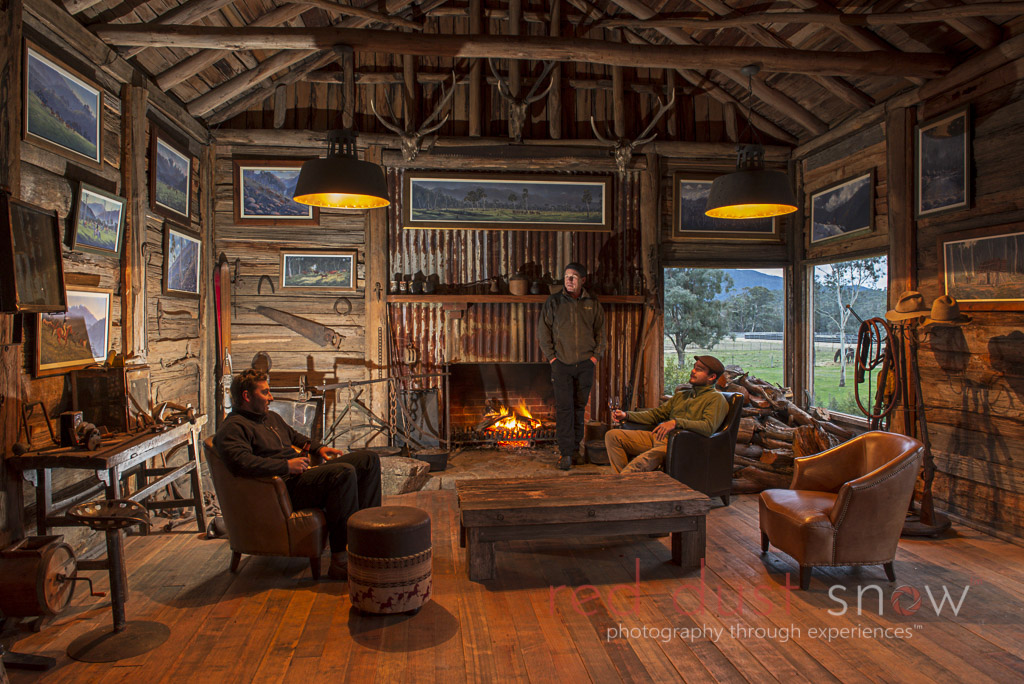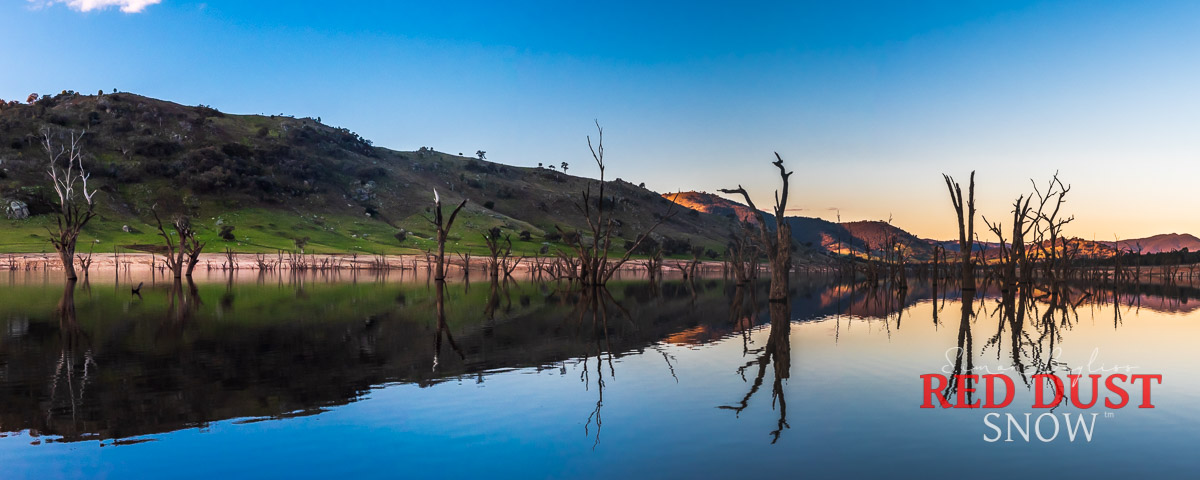Tom Groggin Station: Explore the Heart of the High Country
Victorian High Country Adventures

Tom who?
"There was movement at the station, for the word had passed around..." So starts the iconic Australian poem by Banjo Paterson about a man from the Snowy River who became a legend after he recaptured a prizewinning racehorse that fled his owner's property and joined up with a group of brumbies in the High Country; that man, reputedly, was Jack Riley. So what of this man, the region and the Snowy River? It's time to do a bit of High Country exploring.
There is a place in the foothills of the Snowy Mountains that is set beautifully alongside the Murray River, and it is a place where Jack Riley worked. That place is called Tom Groggin Station.
But who was Tom Groggin? There was no person called Tom Groggin, as many believe. Still, the name is a transliteration of an old Aboriginal word, 'tomarogin', which refers to a water spider living in the Murray River's upper reaches.
The area around Tom Groggin is synonymous with adventure as it is the furthest point upstream of the Murray River one can drive to on a public (gazetted) road. It is also the point known to the more extreme off-roaders for crossing the river to access the 4x4 tracks of the Victorian High Country.
While very cold in winter, summer is a bit of a mecca with large, family-friendly campgrounds beside the Murray River.
Along with the campground on the NSW side, there is also an excellent accommodation option across the river a few km downstream at Tom Groggin Station, on the Victorian side of the Murray. (For the trivia buffs, the NSW/Victorian border is the Victorian side of the river, not down the middle, as many believe).
Tom Groggin Station is an 810-hectare (2,000-acre) working cattle property that has operated continuously as a cattle station since the mid-1800s and was visited by Banjo Paterson and the place Jack Riley worked. Jack passed away in 1914 while riding a bush track from Tom Groggin to Corryong, some 60km through the High Country bush. As legend has it, Jack inspired the Man from Snowy River after Banjo visited the Station several times. It is generally accepted that the Man in the poem was also inspired by a few others from the region, including Owen Cummins and Charlie McKechnie.
High Country Dreaming
So it's off to the Snowy Mountains I go! Heading out of Albury, I could drive from point A to point B, but I particularly like a bit of adventure, so I am taking the 'road less travelled' and have a great route in mind that will crisscross the Towong Shire.
Heading east via Albury and across the Murray River back into Victoria. I say crossing the Murray, and while that is technically correct, the river is not immediately obvious as this is the section of the Murray River just upstream of the Hume Dam that forms the 20,000+ hectare Lake Hume.
Lake Hume and the Snowy Hydro Scheme

The dam, at what was the junction of the Murray and Mitta Mitta rivers, took seven years to build. When it was finished in 1936, it was the largest dam in the southern hemisphere and one of the biggest in the world. To say it is a huge body of water is an understatement, as water retained upstream through the Murray and Mitta Mitta rivers stretches over 40 kilometres and is a haven for water sports, fishing, and camping.
When built, the Hume Dam was designed for a 1,500 Gigalitre capacity, but this was increased to 3,005 Gigalitres in the late 1950s to capitalise on the increased water flow of the Snowy Hydro Scheme that resulted from the fact that the Snowy River, which initially flowed to the east, was tunnelled back through the Great Divide to flow west and into the Murray- Darling Basin. It is amazing when one contemplates the engineering feat of the Snowy scheme and all the migrant workers who built it. For many, their contribution to the project was the major foundation of multicultural Australia.
Driving along the excellent winding Murray River Road, I reminisce about the many times I have driven this road and the Murray Valley Road that parallels to the south along the Mitta Mitta Valley and how often I have asked myself as I pass a certain road, "I wonder what's along there" or, "that looks like a nice track, I wonder if it links back to the other main Upper Murray route". Well, enough questioning and time to find out.
My planned route will cover the Murray River Road as far as Talgarno and then south via Georges Creek Road past Mount Granya State Park and onto Tallangatta. The road up and over the ridge combines bitumen and gravel and reveals some spectacular area vistas. The intermittent gravel roads are a nice warmup to the other tracks further along this route to Corryong.
Tallangatta, known as the town that moved, was relocated from its original position 7km east along the Mitta Mitta River to its current location due to the rise in water levels of Lake Hume that resulted from its increased capacity when the Snowy Hydro scheme was being built in the 1950s.
When the lake is low, as it is now at around 22% capacity, the remnants of the old town are still visible near the roadside interpretive site.
Back on the road and heading east along the Murray Valley Highway to Koetong, where the adventure route continues north along Burrowye Rd, up through the pine plantations and up to the higher ground through thick native forests and excellent trails with plenty of 'wow' moments.
The route then descends to Burrowye Creek through beautiful farming valleys before returning to the bitumen and into Burrowye, then back onto the Murray River Road.
Here, you can see the upper Murray River in all its natural glory as a free-running river. While the Hume Reservoir is a fantastic achievement, and there are arguments for and against damming rivers for whatever purpose, there is no arguing that the natural balance of the river is affected downstream by any dam.
The river around Mt Alfred and Walwa, past Gadd's Bend Camping Ground, Upper MurrayGadd's Bend Camping Ground, Upper Murray, and further up, is a pleasant reminder of nature at its best.
With a quick 25 km along the bitumen, the route heads south from Walwa and into more amazing forest tracks with even more side tracks on offer (noted for next time as time is limited).
"their contribution to the project was the major foundation of multicultural Australia."
Trivia Time
The line in the Man from Snowy River poem, "There was Harrison, who made his pile when Pardon won the cup".
But what Cup did Pardon win?
Most assume it was the Melbourne Cup, but Pardon never won.
It was, in fact, the Menindee Cup.
Heading south along Cudgewa Bluff Road is the best off-bitumen leg of the trip and is a must for anyone travelling through the area.
A specular 25km road through the Burrowa Pine Mountain National Park before joining the Cudgewa- Tinltalda Rd (bitumen), near our next stop at Corryong. For the best vista of this town, with its backdrop against the High Country mountains, head down Briggs Gap Road. Truly spectacular! Corryong is the largest town in the shire (around 1,200 people) and is the gateway to the Snowy Mountains. It is an excellent stopover service town with all amenities and a great museum featuring the history of the area, especially its association with Jack Riley and Banjo Patterson.
Images of Tom Groggin Station:
Up to Scammells Spur
A perfect spot for a quick break and refuel before heading into the High Country and our destination at Tom Groggin 75km away. About 15km out of Corryong, we cross the Murray River and into NSW - there are no roads along the Victorian side of the Murray to Tom Groggin Station, so it is via the Alpine Way in NSW.
As we get closer and closer to the mountains proper, the landscape is remarkable as the small hills turn into larger ones, and the smaller we feel as the mountains loom larger and larger.
The last town before the ascent up to Scammells Spur is Khancoban, a small service town initially built as a base for the Snowy Hydro Scheme in the 1950s.
The climb up to Murray 1 Power Stations soon reveals the place's majesty and the High Country's natural beauty. Climbing further up, Scammells Lookout at 1,100m, the cloud, mist, and mist builds, and visibility is soon down to about 10 metres. The drive over the top features beautiful winding roads through the pristine Eucalypt forests whose heady Eucalyptus scent soon fills the car, even in the colder months.
Visibility is soon restored as we descend below the cloud towards Geehi Plains and then onto Tom Groggin Station, which we make just on the last light. The best thing about arriving as darkness envelopes the valley is that morning will reveal the mountain landscape and Tom Groggin's setting.
With an open fire and cuppa on offer, few things are better than reflecting on the day's adventure. The overwhelming feeling for me is always towards those who opened up this country before any surveyed roads and those who came from post-war Europe to build the Snowy Scheme. It is mind-boggling how they tolerated the conditions in the rudimentary structures and vehicles we enjoy today.
Weather-wise, the following day certainly did not disappoint as we woke to cloudy skies with yesterday's rain gone. The majesty of the mountains was slowly being revealed.
Station Life
Tom Groggin Station, while well known as a location and place of history, many don't realise that it also offers great accommodation in one of the most beautiful parts of Australia. There are two accommodation options available; the first is purely for couples (or good friends) in the fully self-contained one-bedroom log cabin, while the other option is for larger groups in the 4-bedroom, 2-bathroom house with all the mod-cons. While this is fantastic as far as the accommodation is concerned, the use of the timber slab hut that includes a big open fireplace & bar facilities is also on offer. This is an original and not a 'made-to-look-like' structure, complete with old photos, paintings, equipment and memorabilia from a bygone era, when the likes of Jack Riley and Banjo Patterson were around. Wayne, the manager of the property, is a wealth of knowledge on the area and its history, and it is a wonderful experience to sit by the fire and as he regales the history of the station, the people, and even the history of the hut we are sitting in. If those walls could talk.
One of the best things about the remoteness of Tom Groggin Station is that there is no phone reception so it is truly a place to relax and enjoy. A station phone is available for contact with the 'outside world'. Alternatively, it is a short drive back onto the Alpine Way, where mobile coverage is available for certain providers.
With only a couple of days here, it was time to explore. On top of the list is a trip to Olsens Lookout, which provides visitors with a spectacular view of the Main Range and provides some perspective of how big the mountains are.
Olsens Lookout is reached via Geehi Dam Road (also called Olsens Road), about 20km north of Tom Groggin along the Alpine Way. Leaving the Alpine Way, it is an 11km trip to the lookout along an unsealed but well-maintained track that parallels the Main Ridge and reveals a different range perspective at each turn. The lookout reveals the mountain range's true majesty and a worthwhile side trip.
After a few hours of exploring the area, it's time to head back to Tom Groggin, but not before checking out one of the best campgrounds at Geehi Flats, just off the Alpine Way. The area, very popular in the warmer months, has picnic facilities, toilets, good river access, and a huge population of kangaroos.
Back at Tom Groggin, we gather in the slab hut with the fire blazing and a clear view out the window of the fading light, chatting for hours about this journey, about more adventures, about places to go, about the next road trip...
This is what an adventure is all about!
